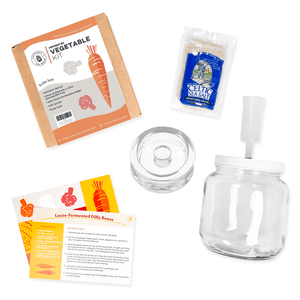
This hot sauce uses red peppers and includes the seeds, so it packs quite a punch. Small amounts of this sauce will make eggs, burgers, fries, and potatoes just a little bit more interesting.
30 minutes
48 minutes
2
INGREDIENTS AND EQUIPMENT AVAILABLE AT CULTURES FOR HEALTH
Fermented Vegetable Kit

Fermented Vegetable Kit
$35.99
Make tasty fermented veggies at home with our DIY Fermented Vegetable Kit!
This kit is also great for making kimchi, sauerkraut, and more! Equipment in the kit may appear different than pictured.
INGREDIENTS:
- 1 cup hot peppers, washed and stemmed (include the seeds)
- 1-1/2 tsp. of salt
- 1 Tbsp. fresh acid whey
- Unchlorinated water, room temperature
- Apple cider vinegar
INSTRUCTIONS:
- In a clean, sanitized pint jar, pack the peppers in just enough water to cover. Add the salt and whey, shake the jar, and cover with an airlock or a regular lid-and-band. Place the jar in a warm place in your kitchen, away from direct sunlight and drafts.
- Let the jar sit on your counter for about 3 to 4 days, shaking it and burping the lid regularly. Once the brine has become really cloudy, it should be ready for the next step.
- Strain the brine out of the peppers into a bowl and save it. Use an immersion blender or a food processor to pulse the remaining soggy peppers. Add a little brine to loosen them up if needed. They should be pretty pureed when you are finished.
- Pour half of the reserved brine, the pepper puree, and about 1/2 cup of apple cider vinegar back into the jar. Put a lid on the jar and shake it up well.
- Place an airlock lid on the jar and let it get a bit bubbly by sitting the jar on the counter for 12 to 24 hours before placing a normal lid on the jar and putting the hot sauce into the fridge.
















